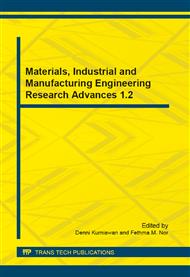p.85
p.89
p.93
p.99
p.105
p.113
p.119
p.125
p.131
Aluminum-Copper Bilayers Thin Films Deposited at Room Temperature by RF Magnetron Sputtering
Abstract:
In this work, the effects of room temperature deposition on the structural properties of Al-Cu bilayers thin films were investigated. The bilayers were sputter deposited by RF magnetron sputtering on Si {100} wafers without substrate heating. The thickness of each layer is approximately 500 nm thick. Characterization were performed with grazing incidence X-ray diffraction (XRD) cross-sectional field emission scanning electron microscope (FE-SEM) with chemical analysis by energy dispersive X-ray (EDX) and atomic force microscope (AFM). It was found polycrystalline Al and Cu thin films have been grown with {111} preferred growth orientation with very fine crystallites size (less than 20 nm). The bilayers were in non-strained condition, but each layer shows different morphologies between the columnar and non columnar structure. AFM analysis revealed that the bilayers top surface appears to have higher surface roughness (Ra = 20 nm) due to low adatoms surface mobility during room temperature deposition.
Info:
Periodical:
Pages:
105-109
Citation:
Online since:
August 2014
Keywords:
Price:
Сopyright:
© 2014 Trans Tech Publications Ltd. All Rights Reserved
Share:
Citation:


